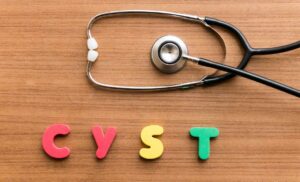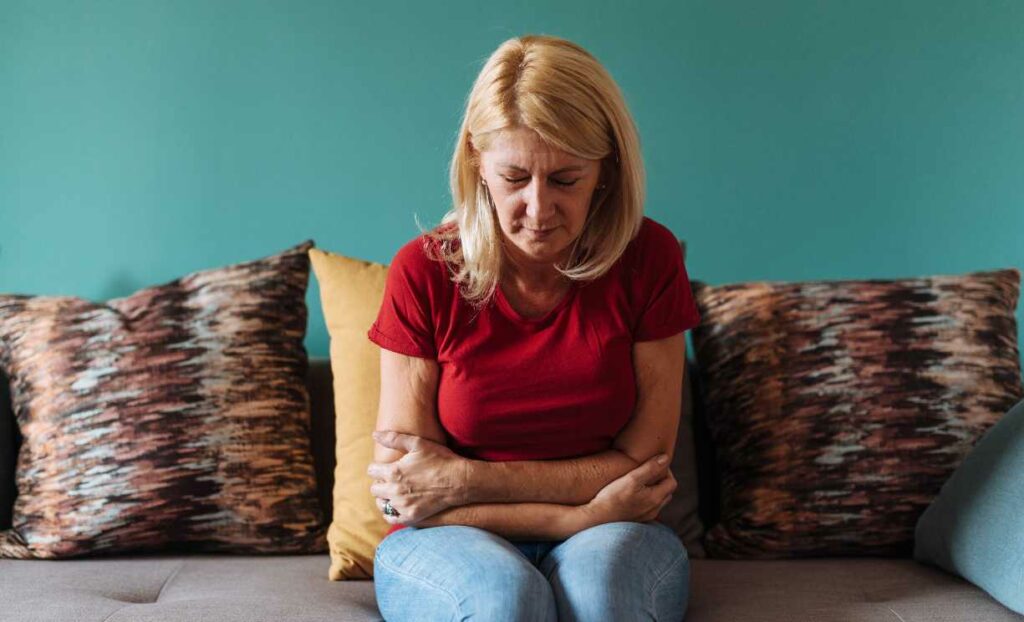Menopause is a natural phase in a woman’s life, signaling the end of reproductive years. However, for some, it may come with unexpected challenges, such as the development of ovarian cysts. Ovarian cysts after menopause raise concerns due to the potential risk of ovarian cancer. In this blog, we will delve into the treatment of ovarian cysts, and their symptoms after menopause.
Contents
What Are Ovarian Cysts?
Ovarian cysts are like small fluid-filled sacs that can form on or inside the ovaries. These cysts are quite common and, in many cases, don’t cause any noticeable symptoms. They can develop as a normal part of the menstrual cycle, known as functional cysts, and often go away on their own without causing any harm. However, some cysts may grow larger or cause discomfort.
Ovarian cysts are typically diagnosed through imaging tests like ultrasounds, and their treatment depends on factors such as size, type, and whether they cause any symptoms. While many cysts are harmless, it’s important to consult with healthcare professionals to determine the best course of action for individual cases.
What Causes Ovarian Cysts?
Ovarian cysts can form for various reasons, and a common cause is a normal part of the menstrual cycle. Each month, the ovaries release an egg during ovulation, and sometimes a small fluid-filled sac, known as a follicle, forms around the egg. In most cases, this follicle breaks open, releasing the egg, and then it dissolves. However, if the follicle doesn’t break open or if it seals up after releasing the egg, it can develop into a cyst. This type of cyst is usually harmless.
Other types of cysts can also form, such as cysts related to endometriosis, which is a condition where tissue similar to the lining of the uterus grows outside the uterus. Additionally, polycystic ovary syndrome (PCOS) can lead to the development of multiple small cysts on the ovaries. While many cysts are a normal part of the reproductive process, some may require medical attention, especially if they cause symptoms or complications. Regular check-ups with healthcare professionals can help monitor and manage ovarian cysts appropriately.
The Link Between Menopause And Ovarian Cysts
During menopause, which is a natural phase marking the end of a woman’s reproductive years, hormonal changes occur that can influence the development of ovarian cysts.
In the postmenopausal period, the ovaries typically produce fewer hormones, and while functional cysts related to ovulation become less common, other types of cysts may still emerge. The decline in progesterone levels relative to estrogen after menopause can contribute to the formation of certain cysts.
While many postmenopausal cysts are benign, there’s a heightened concern for malignancy, making regular check-ups and screenings crucial for monitoring ovarian health during this life stage. If cysts cause symptoms or appear unusual, healthcare providers may recommend further evaluation or intervention to ensure women’s health and well-being after menopause.
Symptoms Of Menopausal Ovarian Cysts
Ovarian cysts can occur during menopause, and while many cysts may not cause noticeable symptoms, some individuals may experience signs that warrant medical attention. The symptoms of menopausal ovarian cysts can include:
- Pelvic Pain: Persistent or sharp pain in the pelvic area is a common symptom. The pain may be on one side or both sides and can range from dull aches to more severe discomfort.
- Bloating or Abdominal Fullness: Some women with ovarian cysts may experience a feeling of bloating or fullness in the abdomen, which can be accompanied by swelling or a sensation of abdominal pressure.
- Changes in Urination: Ovarian cysts may cause pressure on the bladder, leading to changes in urination patterns. This can include increased frequency, urgency, or difficulty emptying the bladder.
- Changes in Bowel Habits: Cysts that put pressure on the intestines may cause changes in bowel habits. This can manifest as constipation, diarrhea, or alterations in the usual pattern.
- Pain During Intercourse: Some women may experience pain or discomfort during sexual intercourse, especially if the cyst puts pressure on surrounding tissues.
- Irregular Menstrual Cycles: Menopausal women may notice changes in their menstrual cycles, including irregular periods or spotting. Ovarian cysts can disrupt the normal hormonal balance and menstrual patterns.
- Unexplained Weight Gain: A persistent and unexplained weight gain not attributed to other factors may be associated with ovarian cysts, particularly if they are large or cause fluid accumulation.
- Fatigue: Ovarian cysts, especially if they are causing hormonal imbalances, may contribute to feelings of fatigue and low energy levels.
Treatment For Ovarian Cysts After Menopause
The treatment for ovarian cysts after menopause depends on various factors, including the type of cyst, its size, and whether it causes symptoms. It’s important to note that while many ovarian cysts are benign, the risk of malignancy increases after menopause, making careful evaluation and appropriate management essential. Here are common approaches to treating ovarian cysts after menopause:
- Watchful Waiting: Small, non-symptomatic cysts may be monitored through regular check-ups without immediate intervention. This approach is often considered when the cyst is likely to resolve on its own.
- Surgical Removal (Cystectomy): If the cyst is large, causing discomfort, or there are concerns about its nature, surgical removal may be recommended. This procedure, known as cystectomy, involves removing the cyst while preserving the ovary.
- Hysterectomy with Bilateral Salpingo-Oophorectomy: In cases where there’s a higher suspicion of malignancy, or for complex cysts, healthcare providers may recommend a more extensive procedure. A hysterectomy involves removing the uterus, and bilateral salpingo-oophorectomy involves removing both ovaries and fallopian tubes.
- Biopsy: If the cyst appears suspicious or if there are concerns about malignancy, a biopsy may be performed. A biopsy involves taking a small tissue sample for laboratory analysis to determine whether the cyst is cancerous or benign.
- Hormone Replacement Therapy (HRT): After the removal of both ovaries, healthcare providers may recommend hormone replacement therapy (HRT) to alleviate menopausal symptoms. HRT provides estrogen and, if necessary, progesterone to balance hormone levels.
- Regular Monitoring: For small cysts that do not require immediate intervention, regular monitoring through imaging studies and check-ups may be advised to track any changes over time.
Managing Menopausal Ovarian Cysts
Management approaches for menopausal ovarian cysts focus on lifestyle modifications that may help alleviate symptoms and promote overall well-being. It’s important to note that while these approaches may offer relief, they are not a substitute for medical advice. Here are some natural management strategies:
- Dietary Modifications: Include foods rich in anti-inflammatory properties, such as fruits, vegetables, whole grains, and fatty fish. These may help reduce inflammation associated with ovarian cysts. Reduce the intake of processed foods, refined sugars, and excessive caffeine, as these may contribute to inflammation and hormonal imbalances.
- Herbal Supplements: Some women use chaste berry supplements to help balance hormones. It is advisable to consult with a healthcare professional before using herbal supplements, especially if taking other medications.
- Omega-3 Fatty Acids: Incorporate foods rich in omega-3 fatty acids, such as flaxseeds, chia seeds, and fatty fish. Omega-3s have anti-inflammatory properties and may contribute to hormonal balance.
- Regular Exercise: Engage in regular physical activity, such as brisk walking, swimming, or yoga. Exercise can help manage stress, maintain a healthy weight, and promote overall well-being.
- Stress Management: Practice stress-reducing techniques, such as meditation, deep breathing exercises, or mindfulness. Chronic stress can impact hormonal balance and may contribute to ovarian cyst symptoms.
- Adequate Sleep: Prioritize sufficient and quality sleep. Sleep plays a crucial role in hormonal regulation and overall health.
- Hydration: Ensure proper hydration by drinking an adequate amount of water. Staying hydrated supports overall health and may aid in flushing toxins from the body.
- Limit Environmental Toxins: Minimize exposure to environmental toxins by choosing natural and organic personal care products. Some chemicals in these products may disrupt hormonal balance.
- Acupuncture: Acupuncture is an alternative therapy that involves the insertion of thin needles into specific points of the body. Some women find it helpful for managing symptoms associated with ovarian cysts.
Conclusion
In conclusion, the treatment of ovarian cysts after menopause requires a careful and individualized approach. While menopausal ovarian cysts can present unique challenges, understanding the available treatment options and staying proactive about one’s health is paramount. Regular monitoring through check-ups and imaging studies is crucial to assess the nature and progression of cysts. Management strategies, lifestyle adjustments, and dietary modifications can complement conventional medical treatments, providing a holistic approach to well-being.
Through a combination of medical guidance, natural approaches, and a commitment to overall health, women can navigate the path of ovarian cyst treatment after menopause with resilience and confidence.
If you are facing menopause-related issues, menopause treatment at HerMantra can help. Book your free trial online menopause treatment session now.






